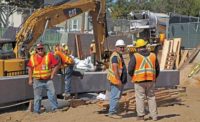How do you pack the construction of four new 14-mile- long lanes, 58 new bridges and 900,000 sq ft of retaining wall into an active highway carrying 200,000 daily vehicles and do it in four years? Virginia’s Capital Beltway expansion team would answer: Pack all the players into one room—early and often. Then, as Virginia Dept. of Transportation senior project manager Larry Cloyed says, the team has to live by the motto “Get it done.”
The $1.35-billion reconstruction of the Capital Beltway—including the addition of two high-occupancy toll (HOT) lanes in each direction—is being performed by a private concessionaire that will also operate and maintain that section over 80 years as part of an overall $2-billion, public-private partnership (P3). This type of arrangement is gaining an increasing foothold throughout the United States. For example, two deals were inked in Texas this year, two projects are under way in Florida, and a transit P3 contract was awarded in Denver.
Informed by lessons learned from previous efforts with regard to design-build, tolling mechanisms, revenue sources and sharing of risk, the Capital Beltway project, entering its midway point, serves as a poster child for the new wave of P3s in America. The new toll lanes also will be the first in the U.S. to double as high-occupancy vehicle lanes. Vehicles with three or more passengers won’t have to pay tolls.
Fluor Corp., Irving, Texas, one of the few American firms that has garnered a lengthy résumé in P3s, is serving both as a partner of the concessionaire team and as the design-build team prime. Concessionaire lead Transurban, Australia, also will serve as the toll operator.
Their dual roles mean taking on both construction and revenue risks. “We’re willing to take on that risk,” says Tim Steinhilber, general manager for the concessionaire team, Capital Beltway Express LLC. “We’re here for the long term.”
Construction is daunting along every mile, including $260 million worth of new infrastructure that is being added to an extremely dense urban corridor, with dozens of new access points to major employment centers. The north-south stretch constantly crisscrosses and connects with other busy arterials and highways as well as, in Tysons Corner, the $2.6-billion first phase of the Dulles metro project. There, piers being built for the elevated guideway directly cross the beltway.
The existing four lanes in each direction must be kept open during rush hour, even as the team builds two new lanes on the highway perimeters to make room for the HOT lanes that will run in the middle. A dozen interchanges will receive upgrades, and access ramps will link the HOT lanes with numerous points, including other carpool lanes on I-66, I-95 and the Dulles Toll Road.
“Every existing bridge abutment between Springfield and Dulles must be demolished and replaced—and [those bridges] carry a lot of traffic,” says Bob Portley, deputy project director of construction for the design-build team, led by Fluor and Lane Construction Corp., Cheshire, Conn.
In many cases, the bridges are rebuilt in three phases: demolish half, switch traffic onto the other half and rebuild the first half, then switch traffic onto the new half and, finally, demolish and rebuild the second half. In five cases, new bridges can be built on entirely new alignments, saving time, says Portley.
Three bridges have been accelerated to save up to a year in schedule. For example, one bridge was originally to be demolished and rebuilt in thirds. “We were able to demolish one-third, build a replacement third, and squeeze the traffic into that third,” says Portley. “Then we could build the rest in one go.”
On the south end of the beltway segment, the team is building one precast concrete girder bridge and seven steel- plate girder bridges, as long as 2,000 ft, for the Springfield Interchange, which recently received a $650-million widening in seven phases. VDOT asked the design-build team to...








Post a comment to this article
Report Abusive Comment